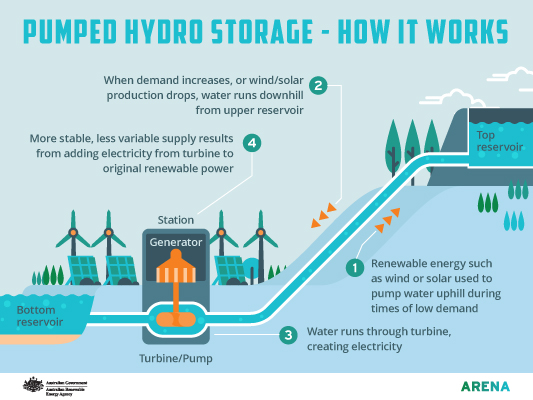29th April 2020
Early in February 2020, SOMR sent a letter with questions about various issues affecting the Macleay River to the Oxley MP and Minister for Water Melinda Pavey. One of the questions was: “Are you supporting/planning pumped hydro developments? If so, are locations identified?”
In her response of 19th March 2020, the Minister wrote “I have not received any formal briefing about pumped hydro developments for the Macleay River”.
Only days after receiving the Minister’s response, the SOMR committee became aware of the proposed ‘Oven Mountain Pumped Hydro Storage’ (OMPHS) project, located within the Macleay catchment and it has already received substantial government funding. The Minister’s response was either incorrect or ill-informed.
To gain more detail of the Proposal, SOMR is currently contacting the proponents of the project, Armidale Regional Council, Kempsey Shire Council and offices of the Department of Planning, Industry and Environment (DoPIE) and research scientists. We await responses.
Project History.
A pumped hydro electricity generator in the Upper Macleay was first proposed about 20
years ago. The location at Oven Mountain on the Carrai Plateau seemed suitable,
however Lend-Lease took out an option on the scheme and conducted their own extensive
surveys and feasibility studies to then abandon it as holistically unviable.
The current Oven Mountain Pumped Hydro Storage (OMPHS) project is proposed by Oven Mountain Pty Ltd, partnered with Hong Kong based company Alinta Energy (AE) and ‘supported’ by consultants Lloyd’s Register, Snowy Mountain Electricity Commission (SMEC) (now Snowy Hydro Limited) and Ernst & Young (EY) economic consultants.
The Proposal.
The Oven Mountain development proposes, one upper-level storage dam on the Carrai Plateau and a lower-level storage dam near the Macleay River, with an approximate height difference of 600m. The two dams are to be linked by a tunnel with a turbine close to the lower dam. In periods of peak electricity demand, water is released at the top, to drive the turbines and generate electricity. In periods of low demand water from the lower dam is to be pumped back up to the upper level dam using wind and solar power. This means the water is circulated in a closed loop system and only needs low volume pumping from the Macleay River to top-up the system losses when available.
The proposal is for the upper dam to act as a battery for the turbines to generate 600MW or 7200 MW hours of power.

Government funding.
A $2.2 million study as to how the proposed project could support the network was contributed to by two Government funding grants:
- In 2017, NSW Government’s Emerging Energy Program granted pre-investment studies funding. (SOMR is researching the amount) and
- In April 2020, the Federal Government’s Australian Renewable Energy Agency (ARENA) granted just under $1.0 million for the project.
Government Policy.
In 2018, The NSW Government’s Energy NSW and the Australian National University (ANU), investigated the potential for further pumped hydro developments, and prepared the Pumped Hydro Roadmap, which identifies and maps opportunities for pumped hydro across NSW, including on the North Coast. – Link to the Pumped Hydro Roadmap: https://energy.nsw.gov.au/renewables/clean-energy-initiatives/hydro-energy-and-storage
This document relays that:
- The ‘North East’, this escarpment area, has the highest potential for Pumped Hydro in NSW through ANU’s assessment of topography, climate, rainfall, water availability and transmission capacity.
- The NSW Government invites private development proposals of pumped hydro and
- The NSW Government will, with some conditions, process the Applications as State Significant Developments or State Significant Infrastructure, i.e. assessed and approved by The Minister for Planning.
Concerns and questions arising:
While SOMR appreciates investment in the renewable energy sector, we have significant concerns and questions about; foreign ownership, the remote geographical and geological location, with the potential environmental impact on the Macleay River from the project and related infrastructure construction and operation.
Concerns:
- The site is adjacent to a National Park and in the vicinity of wilderness areas with World Heritage listed Gondwana Forests not too far away.
- Construction and maintenance of transmission lines connecting the project to the grid most likely would traverse this wilderness area and National Parks.
- The impact of earthworks on steep, remote and relatively pristine landscape and with the potential for release of Antimony and Arsenic from the substrate.
- How much and how often would water from the Macleay River be needed to top up the ‘closed-water’ system.
- Road access for construction and operation will need to follow and cross/bridge the Macleay River above Georges Creek Junction in remote ‘gorge’ country.
- Whether the environmental impacts of construction for a 50year design-life would be less, or more, than mining for metals and manufacture of batteries with 15year design-life and recycling opportunities.
- The net energy gain from new pumped hydro developments has been questioned by experts for other pumped hydro projects in other areas of NSW. Questions:
- The proponents state that the energy needed for pumping the water to the upper reservoir will come from solar and wind power – when available. Does that mean it would be from the grid?
- The project is located on private land with overseas proponents and Australian Government funding. What is the scope of the private/public relationship of the project?
- What is Planning Stage for this Proposal and under what part of the EPA Act the Application will be lodged?
- What safeguards for rehabilitation after the ‘life of the project’ are to be included in the Approval Conditions if Approved? SOMR is researching further details on the development and, as mentioned above, seeking information from the Proponent, all levels of Government, scientists and stakeholders. Information and comments from SOMR members and readers of this summary are welcome. Links to further information:
https://arena.gov.au/projects/omps-new-england-phes-benefits-study/
https://energy.nsw.gov.au/renewables/clean-energy-initiatives/hydro-energy-and-storage
